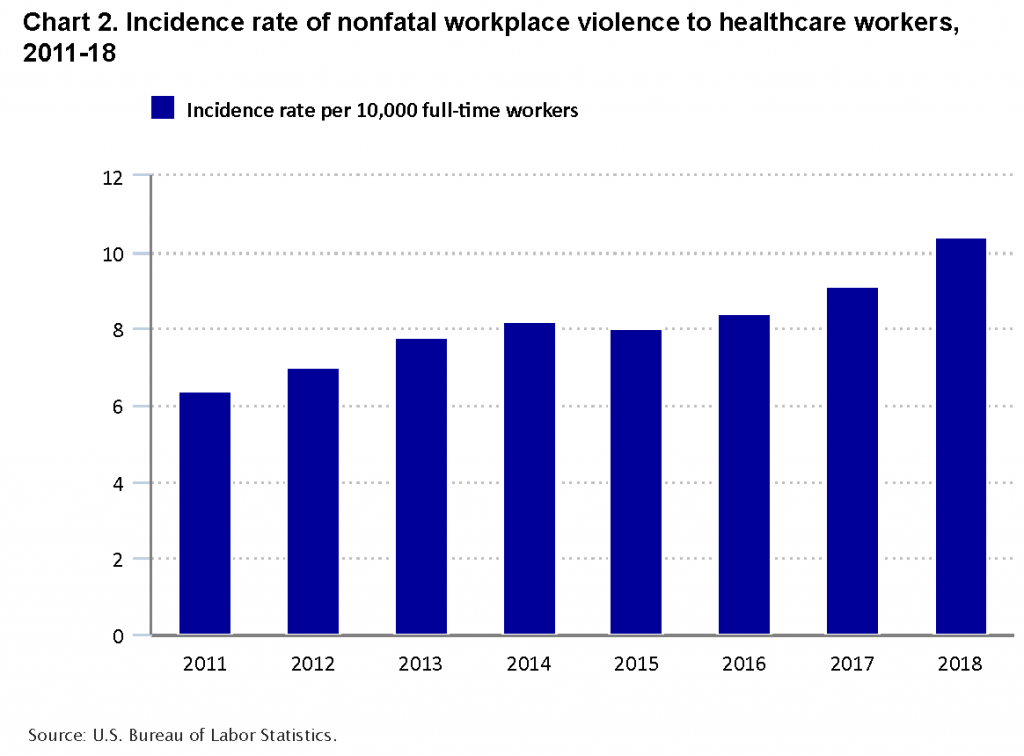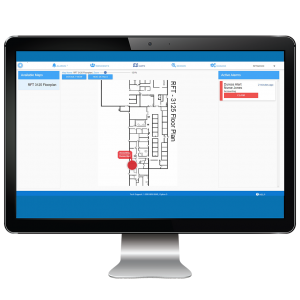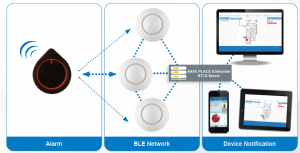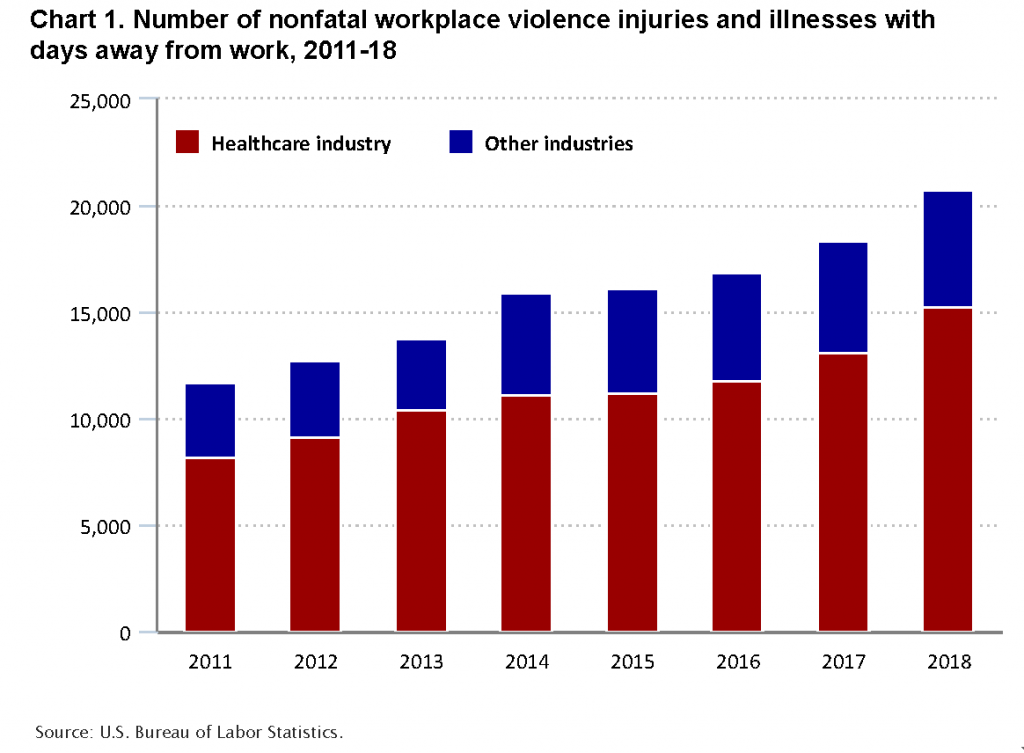Staff Protection: An increasing, yet preventable healthcare violence epidemic
In the aftermath of the Covid-19 pandemic, the benefits, and drawbacks of working in healthcare have come into clear view. One of the existing problems is staff protection. A 2021 report by Scripps Health shows a 17% increase in reports of verbal and physical abuse against staff. Also, the report shows a marked 9% increase in staff injuries because of workplace violence.
The growing problem of violence against healthcare workers needs to stop. Far too many healthcare professionals (HPCs) experience aggressive or unwanted contact from patients or others. Specifically, registered nurses (RNs) experience three times the violent events as all occupations, according to a 2016 BLS report.
This rise in healthcare violence prompted the 2021 Congress to pass H.R. 1195, the Workplace Violence Prevention for Health Care and Social Service Workers Act. Not only has the government responded swiftly, but private sector business as well. RF Technologies, a creator and provider of healthcare notification systems, recently introduced an alert button, named SAFE PLACE® Staff Protection, to help alert staff and mitigate workplace violence.
Effects of Violence in the Workplace
Staff Protection from an Employee’s Viewpoint
In 2021, all U.S. regions saw an increase in registered nurse (RN) turnover rate. As of today, the national hospital turnover rate is 25.9%. And, over the past five years, the average hospital turned over 100.5% of its HCP workforce, according to 2021 data. Of the departures, 95.5% of all hospital separations were voluntary.
From an employee’s viewpoint, potential violence in the workplace negatively affects their likelihood to continue employment. So, ways to mitigate and protect against employee violence are of utmost importance. In addition, employees and employers benefit from protections.
Staff Protection from an Employer’s Viewpoint
Nearly every hospital (96.1%) views staff retention as a “key strategic imperative.” The cost of turnover for an RN ranges from 28,400 to $58,300. This results in the average hospital losing $3.6 million to $7.1 million a year, according to the 2022 National Retention & RN Staffing Report. So, if a hospital improves RN turnover by only 1%, the average hospital would save $270,800 a year.
Many factors result in increased turnover. For example, violence is one of factor affecting turnover. So, every employer should try to minimize violence in the workplace. If an employee experiences a negative health outcome, they require proper time to recuperate. Nearly half of worker injuries and illnesses require days away from work, job transfer or restriction. Clearly, preventing workplace violence is nothing but beneficial for all those involved. Regardless of cause, anytime a workplace experiences staff loss, revenues decrease, expenditures increase, and coverage suffers.
Staff Support
Reporting is one of the main ways to curb the outbreak of violence. However, many barriers exist to reporting. A 2019 report, by the American Nurses Association (ANA), briefed ways in which barriers exist. To elaborate, the report provided recommendations for violence reporting, improving work culture to support staff, and recommendations for prevention.
Those in healthcare consider workplace violence part of the job. They also see it as routine, and minimize its seriousness. Furthermore, there exists a serious lack of training related to reports, manager and employer support, and definitions of what constitutes violence. For instance, does it include verbal harassment?
Reporting workplace violence incidents allows for effective research and regulatory or legal action.
Violence Prevention in Healthcare
Legacy Methods of Staff Protection
According to a 2018 fact sheet by the Bureau of Labor Statistics, healthcare workers “experience the highest rates of injuries by workplace violence and are five times as likely to suffer a workplace violence injury than workers overall.” Similarly, statistics show that the incident rate of non-fatal workplace violence to healthcare workers is on the rise.

With workplace violence on the rise, many healthcare systems take different approaches in stopping it. There are many ways that hospitals attempt to alleviate violence. Some of these include security officers, personnel checkpoints, and identity verification. The problem with these mitigation efforts is that they rely on response staff to notice when an event is taking place. This leaves open a crucial gap in time between when an event occurs versus to its response.
While current methods of prevention certainly help, new technological advances make notifying others for help instantaneous.
Recommendations for Preventing Workplace Violence
The issue brief, Reporting Incidents of Workplace Violence, published by the ANA recommends a “multifaceted strategy to combat the significant issue of workplace violence.”
These recommendations include:
- Stopping violence before it occurs
- Immediate and effective response to violence, including emergency care
- Long-term responses to violence
The ANA also recommends that OSHA, accrediting bodies, federal and state agencies, and trade associations create electronic databases through which employees can anonymously report violent incidents.
New Options for Prevention
With ever-increasing wireless options in tech, staff duress systems have followed suit and have undergone an overhaul. Thus, the market is currently seeing an industry-wide revamp in the way violent episodes are alerted, cataloged, and responded to. Current players in the hospital security market have recently released new systems to aid in staff help.
RF Technologies SAFE PLACE Staff Protection Solutions
About
SAFE PLACE Staff Protection Solutions is a staff duress alert system for use in hospital settings. SAFE PLACE operates over an independent system, with browser-based software, multiple transmitter options, and a simple user interface. The system is scalable to each healthcare setting in which the duress solution is implemented. Because the system operates over Bluetooth 5.0 technology, your health system and staff are left reassured by its reliability.
Advantages
Staff Protection has an easy install design to make deployment quick and is FCC part 15 compliant. In addition, the system is fully scalable to ensure that any sized hospital settings staff are protected from violence by the alert system.
Hardware
Staff Protection is customizable to each user’s preference through four wearable banding options that are small and discrete. For instance, the mobile help alert transmitters include key ring, lanyard, pendant clip, and watch.

Image of the four available SAFE PLACE Staff Protection Solutions wearable options
Software
Support by SAFE PLACE Enterprise software allows for a fast response through a real-time location system (RTLS). The RTLS allows for room-level locating of the staff member the moment an alarm is activated. Enterprise is a virtual server platform that operates on Windows Server 2019 OS with 100% SQL databases. The software eliminates Java and Adobe Flash dependency. It also includes active directory integration. Additionally, RFT provides the option of hosting off-site or locally.

SAFE PLACE Staff Protection Enterprise Software
Positive Outcomes
Staff Protection works by activating the wearable staff alert alarm. From there, a network of gateways receives the signal. Then, these gateways send the signal to the SAFE PLACE Enterprise RTLS Server where notifications are distributed to devices that include phones, tablets, and workstations. A simple user interface makes navigating Enterprise software a breeze. This allows responders to find and assist whoever activated the alarm and come to their rescue before an event escalates to violence.

How the SAFE PLACE Staff Protection Solution works
Staff Protection Benefits
All SAFE PLACE solutions are supported by a team of US-based service professionals. They can be contacted for support by phone, email, and live chat. In addition, factory-trained technicians complete service on the systems. They also provide inspections and certification at any frequency needed.
Use of the Staff Protection system includes customized, peer to peer training, to meet a specific facility’s needs. Classes are offered for all shifts/times either onsite or remote. Additionally, RFT makes refresher training and competency reviews available at customer request. Uniquely, RFT offers support with an educational session, onsite, for the day of and the day after a system goes live.
Request a Free in-person or virtual Product Demo to experience SAFE PLACE Staff Protection Solutions for yourself.
Request a Free in-person or virtual Product Demo to experience SAFE PLACE Staff Protection Solutions for yourself.
About RF Technologies: RFT is a turn-key manufacturer and provider of life safety solutions for the senior living, healthcare, education, and hospitality markets. With 10,000+ installations since their founding in 1987, RFT is a collaborative partner in designing custom-configured solutions that meet each customer’s needs and reduces their liabilities. The RFT family of solutions includes CODE ALERT® call and wander management, SAFE PLACE® patient security, HELP ALERT® staff duress, SENSATEC® fall management products and EXACTRACK® equipment location.
Questions? Contact Marketing at marcomm@rft.com
References:
-
https://www.beckershospitalreview.com/hospital-physician-relationships/scripps-health-sees-17-jump-in-workplace-violence-incidents.html
-
https://www.bls.gov/opub/mlr/2018/article/occupational-injuries-and-illnesses-among-registered-nurses.htm
-
https://www.govinfo.gov/content/pkg/BILLS-117hr1195rh/pdf/BILLS-117hr1195rh.pdf
-
https://www.nsinursingsolutions.com/Documents/Library/NSI_National_Health_Care_Retention_Report.pdf
-
https://www.nursingworld.org/globalassets/practiceandpolicy/work-environment/endnurseabuse/endabuse-issue-brief-final.pdf
-
https://www.bls.gov/iif/oshwc/cfoi/workplace-violence-healthcare-2018.htm
-
https://rft.com/staff-protection/

